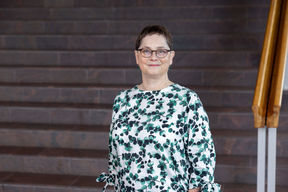New Aalto Distinguished Professor Riitta Salmelin traces the brain’s own ‘fingerprint’

Professor Riitta Salmelin from the Department of Neuroscience and Biomedical Engineering at the School of Science has been appointed as Aalto Distinguished Professor at the opening ceremony of the university's academic year on 5 September. The title of Aalto Distinguished Professor is awarded to professors of exceptional academic merit.
‘Usually, thanks come to a researcher from the outside rather than from the immediate community. It warmed my heart to know that someone closer to home has thought that I have done a good job,’ Salmelin says with a smile.
Salmelin is a physicist who soon after her PhD got carried away by brain imaging. In a research career spanning several decades, she has delved into the depths of the human mind with a wide range of goals, from understanding language processing to preventing memory disorders.
"Once the basics are covered, you can open up questions once left unanswered"
Salmelin is delighted about the rapid progress in her field. When she started her own research in the 1990s, the MEG devices that measure brain magnetic signals had just reached a stage where they could look at the whole head at once, rather than just individual brain regions.
"The first 10 years are spent trying to get to the bottom of everything - whether the signals can be trusted, whether the device is showing what it should. It's all so new and very exciting, and there's a rush to get a full picture of the effectiveness of the method. Therefore, there are a lot of important questions that you don't have time or perhaps even the suitable analytical methods to address,’ says Salmelin.
As an example, she highlights the individual-level differences in brain images that her current research addresses. While their existence was clearly recognised in the early years, the research at that time was so heavily focused on group-level phenomena that the perceived emphasis on individual traits did not become an important issue in the scientific community.
‘Now that we have 30 years of work behind us and are sure enough about certain basics, the brain imaging community is ready and willing to tackle these issues’.
Salmelin talks about the brain's fingerprints, that is, features that are specific to a particular person and can be detected in the brain's magnetic curves. She and her colleagues recently succeeded in reliably distinguishing between individuals using brain imaging. This method is now also being developed as a clinical tool as part of a project to predict people's risk of dementia. The major discovery was made with the help of new artificial intelligence tools.
‘The machine learning model can take into account many variables at the same time; much more than a human who selects, for example, the intensity of a frequency peak. This opens up a new world for researchers,’ says Salmelin.
The work is still ongoing, and the results obtained so far raise intriguing questions for Salmelin: if some people have particularly similar brain functions, are there similarities in their behaviour? Would these be reflected in experiments, and if so, how?
In the longer term, understanding the brain’s individual fingerprint could help, for example, in planning rehabilitation for stroke patients, which is difficult because of individual differences. In basic research, brain fingerprints could in turn help researchers to group subjects based on similarities in brain activity, potentially improving the accuracy of results. At present, subjects are mainly classified rather roughly, for example by handedness or gender.
Hard work and a slow integration into Aalto
Salmelin's research career began at the Helsinki University of Technology (TKK), where she obtained her PhD in 1989. After her doctorate, she went to Paris as a physicist for a one-year postdoctoral visit – and returned to TKK to become a brain scientist.
‘I did an enormous amount of work during my postdoctoral phase. I gave myself 2.5 years to succeed – otherwise I'd throw in the towel and get a real job. At the end of the period, we got a Nature article. I thought that if I could make them believe that I knew something about this, then maybe it means that I can go on to really learn about it," Salmelin smiles.
The hard work paid off, and publications and funding followed one after the other. When Aalto University took its first steps, Salmelin was awarded a full professorship. For a long time though, the new university felt foreign. Now, finally, Salmelin has found the situation has changed.
‘Over the years, I think Aalto has started to become my university.’

Read more news

Study: Internal combustion engine can achieve zero-emission combustion and double efficiency
A new combustion concept that utilizes argon could completely eliminate nitrogen oxide emissions from internal combustion engines and double their efficiency compared to diesel engines.
A new way to measure contagion: the gut bacterium behind blood poisoning can spread like influenza
Neither the antibiotic-resistant nor the highly virulent strains are the most transmissible.Tonmoy Saha Presents Textile Recycling Research at CIMANET Seminar
The CIMANET Research Seminar, held under the theme “Future Leaders in Circular Materials Bioeconomy,” took place on Thursday, December 4, at the Scandic Marina Congress Center in Helsinki.






